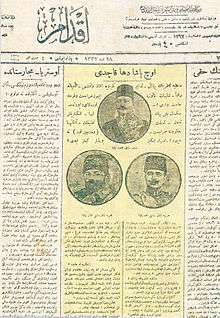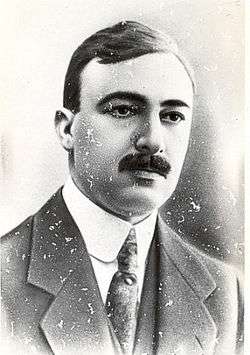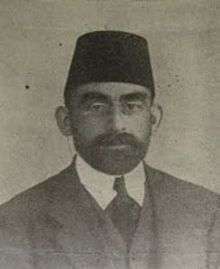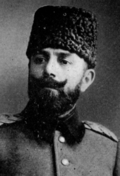Operation Nemesis
| Operation Nemesis | |
|---|---|
|
An exhibition dedicated to Operation Nemesis at the genocide museum in Yerevan, Armenia | |
| Location | Berlin, Tiflis, Constantinople, Rome |
| Date | 1920–1922 |
| Target | Ottoman officials responsible for the Armenian Genocide, Azerbaijani officials responsible for the 1918 massacre of Armenians in Baku |
Attack type | assassinations |
| Perpetrators | Armenian Revolutionary Federation |
| Motive | Vigilante justice[1] and revenge[2][3] |
Operation Nemesis (Armenian: «Նեմեսիս» գործողութիւն Nemesis gortsoghut'iun) was a covert operation by the Armenian Revolutionary Federation (Dashnaktsutyun) carried out between 1920 and 1922, during which a number of former Ottoman political and military figures were assassinated for their role in the Armenian Genocide, as well as Azerbaijani figures for the 1918 massacre of Armenians in Baku. Shahan Natalie and Armen Garo are considered its masterminds.[4] It was named after the Greek goddess of divine retribution, Nemesis.[5]
Background
The Armenian Revolutionary Federation (ARF) was active within the Ottoman Empire in the early 1890s with the aim of unifying the various small groups in the empire who advocated for reform and a certain degree of autonomy within the empire. ARF members formed fedayi guerrilla groups that helped organize self-defense of Armenian civilians. In July–August 1914, the 8th congress of the ARF was a watershed event. Members of the Committee of Union and Progress requested from the party assistance in the conquest of Transcaucasia by inciting a rebellion of Russian Armenians against the Russian army in the event of a Caucasus Campaign opening up.[6][7] The Armenians agreed to remain loyal to their government, but declared their inability to agree to the other proposal.[8]
Prominent ARF members were among the Armenian intellectuals targeted on April 24, 1915 in Constantinople.[9] The arrested people were moved to two holding centers near Ankara under Interior Minister Mehmed Talat's order on April 24, 1915, and mostly deported and killed.
In 1919, after the Armistice of Mudros, the Turkish Courts-Martial of 1919–1920 were convened in Constantinople, during which some of the principal perpetrators of the Armenian Genocide were convicted and sentenced to death.[10] The UK seized some of the perpetrators from the Ottoman authorities in several of Constantinople's prisons, after their incompetency failed to hold fair trials, and transported them to the British colony of Malta. There, the Malta exiles (called so by Turkish sources) were, after Mustafa Kemal Atatürk's incarceration of Lord Curzon's relative, acquitted and exchanged for British prisoners of war by the new Turkish government of Atatürk.[11][12] Since there were no international laws in place under which they could be tried, the men who orchestrated the genocide traveled relatively freely throughout Germany, Italy, and Central Asia.[12]
Congress in Yerevan
On May 28, 1918, the Armenian National Council, a group of professionals based in Tiflis declared the independence of the First Republic of Armenia.[13] Hovhannes Kachaznuni and Alexander Khatisyan, both members of the ARF, moved to Yerevan, Armenia to seize power and issued the official announcement of Armenian independence on May 30, 1918. Yerevan became the capital city in Armenia. At this city, from September 27 to the end of October 1919, the ARF's 9th General Congress convened.
The issue of justice against those responsible for the Armenian Genocide was on the agenda of the congress. Over many of the Russian Armenian delegates' vociferous objections, it was decided to mete out justice through armed force. ARF Bureau members, specifically Simon Vratsyan, Ruben Ter Minasian and Ruben Darbinian, opposed Shahan Natalie's operation. However, a "black list" was created, containing the names of 200 persons deemed responsible for organizing the genocide against the Armenian people.
Operation

The leader of the group responsible for the task was Shahan Natalie, working with Grigor Merjanov. For Natalie, the primary target was Talaat Pasha, whom Shahan called "Number One." The mission to kill Talaat was entrusted to Soghomon Tehlirian. Natalie's aim was to turn Tehlirian's trial into the political trial of those responsible for the Armenian Genocide. In his memoirs, Natalie revealed his orders to Tehlirian: "you blow up the skull of the Number One nation-murderer and you don't try to flee. You stand there, your foot on the corpse and surrender to the police, who will come and handcuff you."[14]
Aftermath
On July 24, 1923, the Treaty of Lausanne, in Lausanne, Switzerland, settled the Anatolian and East Thracian issue of the partitioning of the Ottoman Empire by annulment of the Treaty of Sèvres that was signed by the Constantinople-based Ottoman government.[15]
After the Sovietization of Armenia, many of the First Armenian Republic's expatriate revolutionary activists did not hesitate to collaborate with Azeri and Turk Armenophobe activists to regain governmental control. This policy was contrary to Shahan Natalie's conviction that "Over and above the Turk, the Armenian has no enemy, and Armenian revenge is just and godly." There was deep dissent on both sides, but not yet to the point of separation. To forestall the probable victory of these "freedom fighters" at the upcoming 11th General Congress of the ARF (27 March to 2 May 1929), on the eve of the meeting, the Bureau began a "cleansing campaign." The first to be "removed" from the party was Bureau member Shahan Natalie. "Knowingly" (by his definition) having joined the ARF and unjustly separated from it, Shahan Natalie wrote about this: "With Shahan began again that which had begun with Antranig; Bureau member, Shahan, was 'ousted'". After Shahan were successively ousted Haig Kntouni, Armenian Republic army officer Bagrevandian with his group, Glejian and Tartizian with their partisans, General Smbad, Ferrahian with his group, future "Mardgots" (Bastion)-ists Mgrdich Yeretziants, Levon Mozian, Vazgen Shoushanian, Mesrob Kouyoumjian, Levon Kevonian and many others. As a protest to this "cleansing" by the Bureau, some members of the ARF French Central Committee also resigned.
List of assassinations
Assassinations performed under Operation Nemesis include:[16]
| Date and location | Target | Assassin(s) |
|---|---|---|
| 19 June 1920 |
 Fatali Khan Khoyski Prime Minister of Azerbaijan |
Aram Yerganian Misak Kirakosyan |
| 15 March 1921 |
 Talaat Pasha Minister of Interior and Grand Vizier |
Soghomon Tehlirian |
| 18 July 1921 (Entente-occupied) |
 Behbud Khan Javanshir Minister of Interior of Azerbaijan |
Misak Torlakian |
| 5 December 1921 |
 Said Halim Pasha Grand Vizier |
Arshavir Shiragian |
| 17 April 1922 |
 Behaeddin Shakir Founding member of the Committee of Union and Progress |
Aram Yerganian |
| 17 April 1922 |
 Cemal Azmi Wāli of Trebizond Vilayet |
Arshavir Shiragian |
| 25 July 1922 |
 Djemal Pasha Governor of Syria and Minister of the Navy |
Stepan Dzaghigian Bedros D. Boghosian |
See also
- Frontier justice
- Heroic Corps, part of Korea's liberation movement during Japanese occupation
- Operation Wrath of God, conducted by Israel in response to the Munich massacre
References
- ↑ Frey, Rebecca Joyce (2009). Genocide and International Justice. New York: Infobase Publishing. p. 82. ISBN 9780816073108.
- ↑ Totten, Samuel; Jacobs, Paul R. Bartrop (2008). Dictionary of genocide. Westport, Conn.: Greenwood Press. p. 320. ISBN 9780313346415.
- ↑ Freedman, Jeri (2009). The Armenian genocide (1st ed.). New York: Rosen Pub. Group. p. 42. ISBN 9781404218253.
- ↑ Eminian, Sarkis J. (2004). West of Malatia: The Boys of '26. Bloomington, IN: AuthorHouse. p. 3. ISBN 9781418412623.
- ↑ Newton, Michael (2014). Famous Assassinations in World History: An Encyclopedia [2 volumes]. ABC-CLIO. pp. 269–70. ISBN 1610692861.
- ↑ Taner Akcam, A Shameful Act, p. 136
- ↑ Richard G. Hovannisian, The Armenian People from Ancient to Modern Times, 244
- ↑ The Encyclopedia Americana, 1920, v.28, p. 412
- ↑ Finkel, Caroline, Osman's Dream, (Basic Books, 2005), 57; "Istanbul was only adopted as the city's official name in 1930..".
- ↑ Charny, Israel W.; Tutu, editor in chief; forewords by Archbishop Desmond; Wiesenthal, Simon (2000). Encyclopedia of genocide (Repr. ed.). Oxford: ABC-Clio. ISBN 0874369282.
- ↑ "Turkey's EU Minister, Judge Giovanni Bonello And the Armenian Genocide - 'Claim about Malta Trials is nonsense' - The Malta Independent". Independent.com.mt. 2012-04-19. Retrieved 2016-11-17.
- 1 2 Power, Samantha. "A Problem from Hell", p. 16-17. Basic Books, 2002.
- ↑ Hovannisian. "Armenia's Road to Independence", p. 298.
- ↑ "Nayiri" weekly, v. 12, nos. 1-6
- ↑ "ARTICLE 91". Wwi.lib.byu.edu. Retrieved 2016-11-17.
All grants of patents and registrations of trade-marks, as well as all registrations of transfers or assignments of patents or trade marks which have been duly made since the 30th October, 1918, by the Imperial Ottoman Government at Constantinople or elsewhere..
- ↑ "Perpetrators of the Armenian Genocide". Operation Nemesis. Retrieved 2016-11-17.
Further reading
- Natalie, Shahan (2002) [1928]. The Turks and Us. Nagorno-Karabakh: Punik Publishing.
- Yerganian, Aram (1949). Այսպէս Սպաննեցինք (In this way, we killed) (in Armenian). Los Angeles.
- Shiragian, Arshavir (1976). The Legacy. Sonia Shiragian. Boston, Massachusetts: Hairenik Press. LCC 76-49796.
- Avakian, Lindy V. (1989). The Cross and the Crescent. USC Press. ISBN 0-943247-06-3.
- Derogy, Jacques (1990). Resistance & Revenge. Transaction Publishers. ISBN 0-88738-338-6.
- Alexander, Edward (2000). A Crime of Vengeance. Backinprint.com. ISBN 0-595-08885-6.
- Yeghiayan, Vartkes (2006). The Case of Soghomon Tehlirian. Center for Armenian Remembrance. ISBN 0-9777153-1-0.
- Yeghiayan, Vartkes (2006). The Case of Misak Torlakian. Center for Armenian Remembrance. ISBN 0-9777153-0-2.
- Bogosian, Eric (2015). Operation Nemesis: The Assassination Plot that Avenged the Armenian Genocide. Little, Brown and Company. ISBN 978-0316292085.
